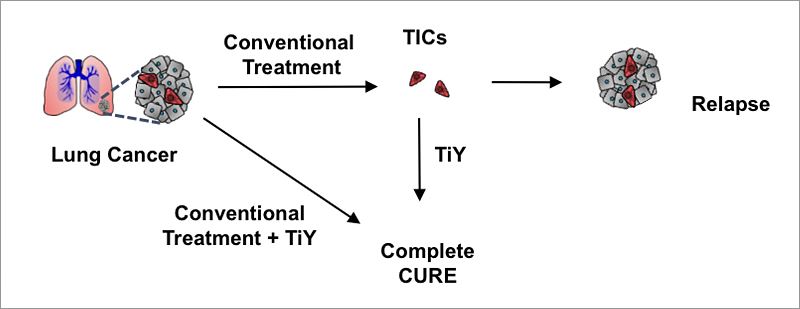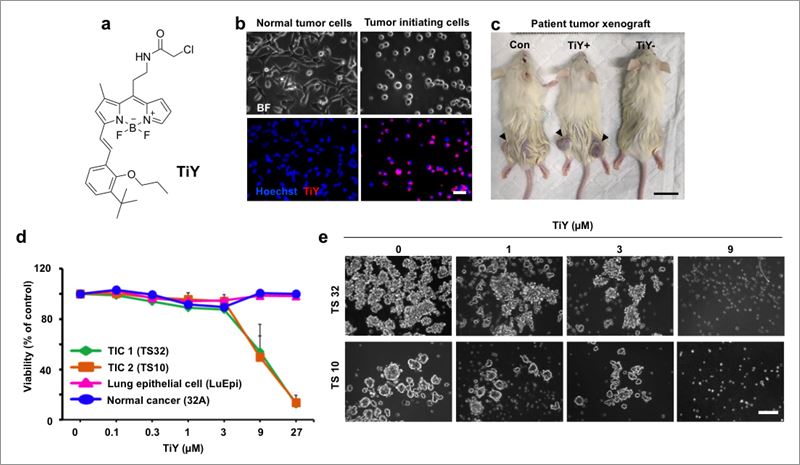| Title of announcement | Versatile Sensor Against Tumor Initiating Cells | ||||
|---|---|---|---|---|---|
| Business forms | Y | Expiration date for bidding | |||
| Department in charge | 전체관리자 | Registration Date | 2018-02-07 | Hits | 2209 |
| att. | |||||
|
|
|||||
Versatile Sensor Against Tumor Initiating Cells- New sensor identifies and suppresses tumor initiating cells, Most cancer deaths are caused by recurrent or metastatic tumors. Conventional therapies target rapidly dividing tumor cells, but are unable to eradicate the highly chemoresistant tumor initiating cells (TICs), ultimately responsible for relapse and spreading of the tumors in other parts of the body. A team of researchers at the Center for Self-assembly and Complexity, within the Institute for Basic Science (IBS) developed the first fluorescent sensor to visualize TICs. Functional in lung, central nervous system, melanoma, breast, renal, ovarian, colon, and prostate cancer cell cultures, this could become a useful tool for biopsy-free post-treatment assessment and anti-TIC drug development. The study was conducted in POSTECH (Pohang, South Korea), in collaboration with the Agency for Science Technology and Research (A*STAR, Singapore), and is published in Angewandte Chemie International Edition. In some cases, a minority of cells called TICs, or cancer stem cells, are culpable of repopulating the tumor after therapy. Their stem cell-like properties enable them to maintain a pool of cancer stem cells within the tumor, as well as to produce new mature tumor cells. Although some TIC-targeting antibodies are available, there is not a single universal antibody which covers all kinds of TICs from different tissues. By screening thousands of fluorescent chemicals, the team developed TiY, a sensor that selectively stained the TICs of non-small cell lung cancer, which accounts for around 85% of all lung cancers. They found out that TiY is capable of distinguishing TICs from non-TICs in various human lung cancer cell lines and patient-derived lung tumors.
Beyond lung cancer, TiY is able to target TICs in 28 types of human cell lines derived from the central nervous system, melanoma, breast, renal, ovarian, colon, and prostate cancer. “TiY has the features of a universal probe, applicable to various kinds of cancer regardless of the origin of the tissue,” explains CHANG Young-Tae.
The researchers have discovered that TiY binds to an intracellular protein called vimentin. Part of the cytoskeleton, vimentin gives flexibility and structure to the cell, but it is also a marker of epithelial-mesenchymal transition (EMT), which is considered a crucial event for metastasis in epithelial tumors. The EMT process allows cells to detach from their neighbors and adopt a migratory and invasive behavior. Although this is a normal process in embryogenesis to build new tissues, when it occurs in cancer cells it generates metastasis. Although vimentin is a known TIC biomarker and anti-vimentin antibodies are available, these cannot enter living cells, and thus could not be used for live TIC detection. On the contrary, TiY is a drug-like small molecule with the unique property of detecting TICs in vivo without biopsy and isolating viable TICs for further studies. In the lab, TICs are able to grow as sphere-looking structures, the so-called tumor spheres, easily recognizable under the microscope. The researchers have discovered that this sphere-forming ability is directly influenced by vimentin as higher concentrations of TiY resulted in the inhibition of sphere formation. Moreover, the team compared TiY with a known vimentin-inhibitor, withaferin A (WFA) and observed that TiY has a stronger selectivity towards TICs than WFA, when compared with toxicity to normal cells and non-TIC cells.
Additional experiments also showed that TiY can suppress the tumor growth in mice xenograft model. Currently, studies for comprehensive application of TiY to a broader range of cancer examples are underway, together with screenings of anti-TIC drug platforms.
Letizia Diamante Notes for editors - References - Media Contact - About the Institute for Basic Science (IBS) |
|||||



